Full Text Searchable PDF User Manual
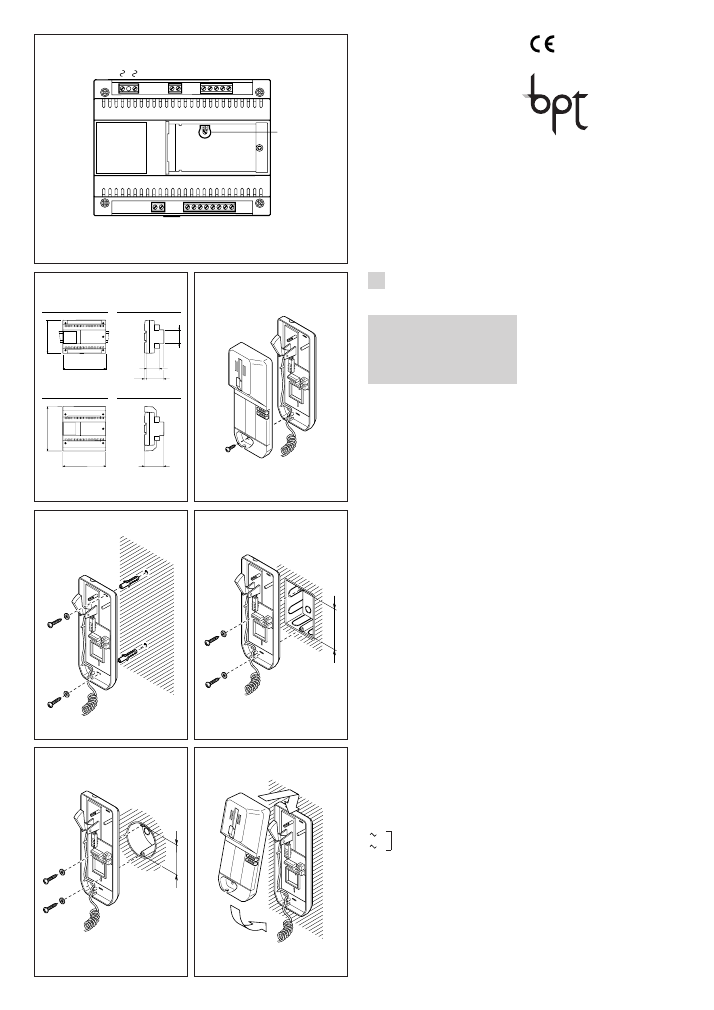
1
03.2007/2402-0674
43,5
45
7,5
57
140
106
A
B
64,5
140
145
A
C
B
1 2 3 5
11 10
9 8 7 6 5 4
P1
E
D
2 1
1 2
6
1
5
60 mm
6
83,5 mm
4
2
3
2
1
7
I
ISTRUZIONI PER
L’INSTALLAZIONE
Attenzione.
Prima di procedere all’installazio-
ne dell’apparecchio leggere
attentamente le “AVVERTENZE
PER L’INSTALLAZIONE” contenu-
te nella confezione.
ALIMENTATORE E/310.01
L’apparecchio viene utilizzato per
realizzare semplici sistemi di inter-
comunicazione, con un massimo
di tre apparecchi, assicurando
anche la possibilità di conversare
fra questi ed il posto esterno.
Impianti con due apparecchi inter-
comunicanti possono essere rea-
lizzati impiegando derivati interni
standard, sfruttando per la chia-
mata, il pulsante ausiliario.
Durante una conversazione tra
intercomunicanti, l’apparecchio
garantisce la completa separazio-
ne audio (e quindi la riservatezza)
rispetto al posto esterno.
È munito di amplificatore audio (il
volume dell’altoparlante del posto
esterno può essere regolato median-
te potenziometro P1 accessibile
attraverso il coperchio, fig.1) e di un
trasformatore, la cui potenza garanti-
sce anche l’alimentazione delle lam-
pade d’illuminazione dei pulsanti
portanome della targa esterna.
La nota di chiamata è del tipo bito-
nale se proveniente dal posto
esterno (la nota di conferma della
chiamata è udibile al posto ester-
no), continua se proveniente da un
derivato interno intercomunicante.
Il comando dell’elettroserratura è
realizzato tramite il contatto di un
relè.
Funzione dei morsetti (fig.1)
Morsettiera A
rete
Morsettiera B
4
comune chiamata al posto
esterno
5
audio al posto esterno
6
audio dal posto esterno
7
+12 V cc per posto esterno ed
accessori
8
massa
9
15 V ca per lampade illumina-
zione pulsanti
10
12 V ca per elettroserratura
11
0 V ca
Morsettiera C
1
massa
2
audio dai derivati interni
3
audio ai derivati interni
5
+12 V cc per accessori
6
comune chiamata ai derivati
interni
NOTA. L’apparecchio è equipaggia-
to con due morsettiere D-E, colle-
gate tra di loro, per agevolare il col-
legamento dei conduttori di chia-
mata in impianti fino a due chiama-
te.
Morsettiera D
1
chiamata n.1 dal posto esterno
2
chiamata n.2 dal posto esterno
Morsettiera E
1
chiamata n.1 al derivato interno
2
chiamata n.2 al derivato interno
Caratteristiche tecniche
• Alimentazione: 230 V ca 50/60
Hz.
Il trasformatore è protetto elettro-
nicamente contro sovraccarichi
e cortocircuiti.
• Potenza assorbita: 10 VA.
• Tensioni d’uscita (protette elettro-
nicamente):
12 V cc 150 mA
per l’alimenta-
zione dei derivati interni, del
posto esterno e di eventuali
accessori.
15 V ca 400 mA
per l’alimenta-
zione delle lampade per l’illumi-
nazione dei pulsanti.
12 V ca 1 A
per l’alimentazione
dell’elettroserratura.
• Chiamata bitonale dal posto
esterno.
• Chiamata a nota continua del
derivato interno intercomunican-
te. Il segnale di chiamata è appli-
cato agli altoparlanti delle cor-
nette; è consigliabile quindi non
collegare più di 3 derivati interni
in parallelo sulla stessa chiama-
ta, cosa che comporterebbe un
indebolimento del volume della
stessa.
• Temperatura di funzionamento:
da 0 °C a +35 °C.
• Dimensioni: modulo da 8 unità
basso per guida DIN (vedere la
fig. 2).
E/310.
01
C/200+P3
XC/200+XP3
YC/200+YP3
BPT S.p.A.
Via Roma, 41
30020 Cinto Caomaggiore-VE-Italy
www.bpt.it-info@bpt.it
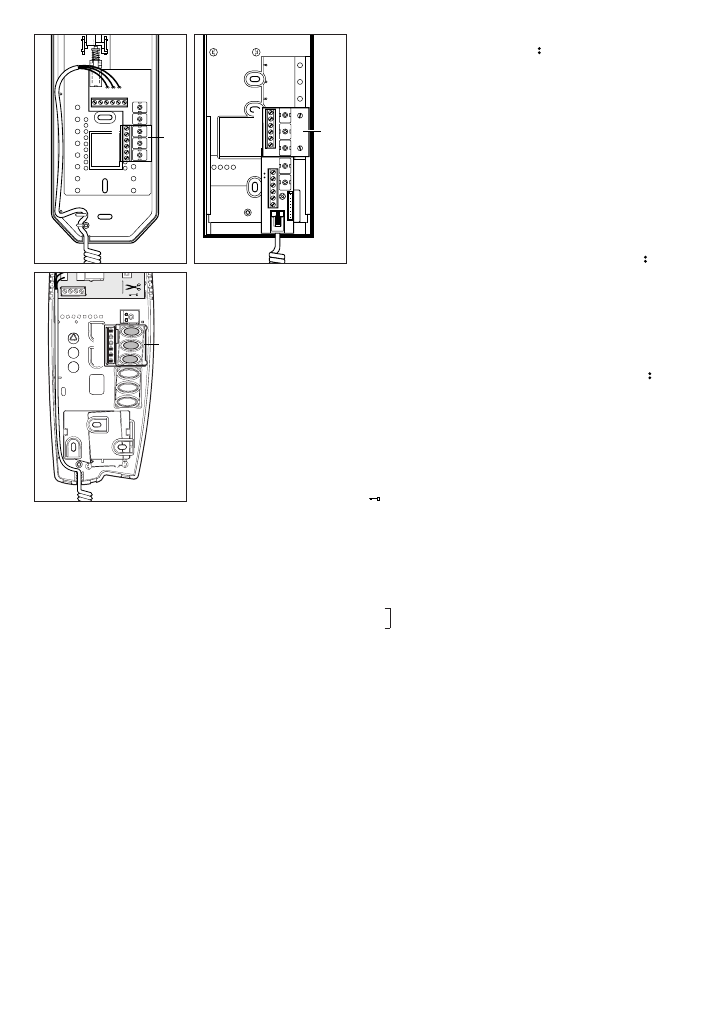
2
L’apparecchio può essere installa-
to, senza coprimorsetti, in scatole
munite di guida DIN (EN 50022).
Per le dimensioni di ingombro
vedere la fig. 2A.
Oppure può essere installato a
parete utilizzando la guida DIN in
dotazione, applicando il coprimor-
setti ed eventuali tasselli in dota-
zione.
Per le dimensioni di ingombro
vedere la fig. 2B.
NOTA. La protezione del trasforma-
tore dell’apparecchio contro so-
vraccarichi e cortocircuiti è ottenuta
elettronicamente anzichè mediante
fusibili.
Per ripristinare il normale funziona-
mento, in caso d’interruzione, biso-
gna:
a) togliere l’alimentazione all’appa-
recchio
b) eliminare le cause dell’arresto
c) far raffreddare l’apparecchio per
almeno un minuto
d) ricollegare l’apparecchio.
CITOFONO C/200
L’apparecchio è dotato di chiama-
ta elettronica.
Qualora l’impianto preveda una
chiamata differenziata (es. dal pia-
nerottolo), inserire il ronzatore
ER/12 nell’apposita sede della
base.
Il citofono è predisposto per l’inse-
rimento del modulo P3.
È munito dei seguenti comandi:
Apriporta
•
Servizi ausiliari
Funzione dei morsetti (fig. 8)
Morsettiera C
5
massa
7
chiamata
8
audio dal posto esterno
9
audio al posto esterno
•
pulsante per
•
servizi ausiliari
Caratteristiche tecniche
• Potenza massima commutabile
del pulsante servizi ausiliari:
max. 24 V 1 A.
• Temperatura di funzionamento:
da 0 °C a + 35 °C.
• Dimensioni: 88x220x70 mm.
Istruzioni per l’installazione
Dopo aver tolto il mobile (vite fron-
tale di fig. 3, in basso), fissare la
base direttamente al muro (fig. 4),
oppure alla scatola incasso (fig. 5
o 6).
Su pareti non perfettamente piane
evitare il serraggio eccessivo delle
viti.
Effettuare i collegamenti e rimette-
re il mobile (fig. 7).
CITOFONO XC/200
Di caratteristiche simili al C/200.
È predisposto per l’inserimento del
modulo XP3.
- Dimensioni: 110x224x65 mm.
CITOFONO YC/200
Di caratteristiche simili al citofono
C/200, è predisposto per l’inseri-
5 7 8 9
• •
12
7
13
14
15
16
P3
5 7 8 9
7
12
13
14
15
16
C
BP1
YP3
10
8
mento del pulsante servizi ausiliari
(
) YP1 e dell’altoparlante YAL
per potenziare la nota di chiamata.
- Dimensioni: 98x215x63 mm.
Nota. Negli impianti intercomuni-
canti il pulsante apriporta è attivo
quando si è in comunicazione con il
posto esterno.
Pulsante apriporta
Normalmente il pulsante apriporta
è sempre attivo. Qualora lo si
volesse attivo solo a cornetta solle-
vata, tagliare il ponticello a filo BP1
(fig. 10).
CITOFONO YC/200A
Di caratteristiche simili al citofono
YC/200, è munito anche di un pul-
sante per servizi ausiliari
.
- Potenza massima commutabile
del pulsante servizi ausiliari: max.
24 V, 1 A.
È predisposto per l’inserimento del
modulo YP3.
PULSANTE AUSILIARIO YP1
Accessorio da inserire nel citofono
YC/200 per avere a disposizione il
pulsante servizi ausiliari (
) Aux
2.
Caratteristiche tecniche
• Potere d’interruzione: 24 V 1 A
max.
• Temperatura di funzionamento:
da 0 °C a + 35 °C.
ESPANSIONE DI CHIAMATA
A 3 PULSANTI P3-XP3-YP3
Permette di trasformare un sempli-
ce citofono in un apparecchio
intercomunicante.
Funzione dei morsetti (fig. 8÷10)
12
uscita chiamata dal posto
esterno
7
ingresso chiamata dal posto
esterno
13
comune chiamata intercomuni-
cante
14
chiamata al derivato n. 1
15
chiamata al derivato n. 2
16
chiamata al derivato n. 3
Istruzioni per l’uso del citofono
intercomunicante
Per chiamare uno degli apparecchi,
alzare la cornetta, premere il pul-
sante desiderato (il segnale di chia-
mata è una nota a tono continuo) e
attendere la comunicazione.
La conversazione interna non può
essere sentita all’esterno.
La chiamata proveniente dal posto
esterno è caratterizzata da una nota
bitonale (se l’apparecchio chiamato
è in conversazione, la chiamata è
segnalata in forma attenuata).
Se una chiamata dall’esterno arriva
durante una conversazione interna
e si desideri quindi entrare in comu-
nicazione con il visitatore, è neces-
sario che tutte le cornette vengano
prima riagganciate; sollevando
quindi la cornetta dell’apparecchio
chiamato si potrà conversare con il
visitatore esterno.
SMALTIMENTO
Assicurarsi che il materiale d’im-
ballaggio non venga disperso nel-
5
7
8
9
C
12
7
13
14
15
16
XP3
9

Terminal block C
1
ground
2
audio from receivers
3
audio to receivers
5
+12 V DC for auxiliary services
6
call common to handsets
NOTE. The power supplier is equip-
ped with two terminal blocks D-E
which are connected to each other
to facilitate the connection of call
wires in systems whith 1 and 2
calls.
Terminal block D
1
call n.1 from entry panel
2
call n.2 from entry panel
Terminal block E
1
call n.1 to handset
2
call n.2 to handset
Technical features
• Mains: 230 V AC 50/60 Hz.
The transformer primary is elec-
tronically protected against over-
loading and short circuiting i.e.
no fuses are used.
• Rated power: 10 VA.
• Output voltages, electronically
protected:
12 V DC 150 mA,
supply voltage
to entry panel and auxiliary servi-
ces as required.
15 V AC 400 mA,
supply voltage
call buttons lamps.
12V AC 1 A,
supply voltage to
door release solenoid.
• Electronic dual-tone note for call
made from entry panel.
• Single tone for intercom call.
Since the call signal is applied to
the loudspeakers of handsets,
we recommended to avoid con-
nection of no more than 3 hand-
sets in parallel to the same call.
This to avoid a decrease in call
volume.
• Working temperature range: from
0 °C to + 35 °C.
• Dimensions: 8 DIN units module,
low profile, figure 2.
The unit can be installed without
terminal covers into boxes provi-
ded with DIN rail (EN 50022).
Dimensions are shown in figure 2A.
Or it can be wall-mounted using
the DIN rail provided, applying as
necessary the terminal covers and
plugs provided.
Dimensions are shown in figure 2B.
NOTE. The transformer primary is
electronically protected against
overloading and short circuiting i.e.
no fuses are used.
a) Disconnect the mains from the
unit.
b) Remove the cause of malfunc-
tion.
c) Let the equipment to cool for at
least 1 minute.
d) Reconnect the mains to the unit.
C/200 HANDSET
The handset call tone is electronic.
When the personal door-bell is
required to be part of the audio
entry system, insert the ER/12 buz-
zer in the apposite guide in the
handset.
It can accommodate the module
P3.
3
GB
INSTALLATION
INSTRUCTIONS
Attention.
Before installing the unit, care-
fully read the “WARNINGS FOR
INSTALLATION” contained in the
package.
POWER SUPPLIER E/310.01
This units is used to create simple
intercommunication systems with a
maximun of 3 internal units to ena-
ble both communication between
internal units and the entry panel.
Audio intercom installations, limi-
ted to 2 handsets, can be made
using standard handset. The auxi-
liary button is used for the inter-
com call.
During a conversation between
internal units the power supplier
guarantees complete audio pri-
vacy (and therefore complete con-
versation confidentiality) with
respect to the entry panel.
The power supplier is equipped
with an amplifier that regulates the
audio volume of entry panel loud-
speaker by means of a potentio-
meter accesible after cover has
been removed, figure 1, and with
an transformer to power the button
illumination lamps in the entry
panel.
The call from the entry panel is
dual tone and a note is heard at the
entry panel confirming the call,
whilst the intercom call is single
tone.
The door lock release solenoid is
activated by a relay contact.
Function of each terminal
(figure 1)
Terminal block A
mains
Terminal block B
4
call common to entry panel
5
audio to entry panel
6
audio from entry panel
7
+12 V DC for entry panel and
auxiliary services
8
ground
9
15 V AC for call button lamps
10
12 V AC for door release sole-
noid
11
0 V AC
It is equipped with the following
controls:
Door lock release button
•
Auxiliary services
Function of each terminal
(figure 8)
Terminal block C
5
ground
7
call
8
audio from entry panel
9
audio to entry panel
•
button for
•
auxiliary services
Technical features
• Max. switching capacity of auxi-
liary services button contact:
max. 24 V, 1 A.
• Working temperature range: 0 °C
to +35 °C.
• Dimensions: 88x220x70 mm.
Installation instructions
Untighten the fixing screw and
remove the front cover from the
back housing, figure 3.
Fix the back housing to the wall,
figure 4, or to an embedding box,
figure 5, 6.
Avoid excessive tightening of the
screws especially when walls are
not perfectly flat.
Make the relative connections and
re-fit the cover (figure 7).
XC/200 HANDSET
Features similar to handset C/200,
it can accommodate the module
XP3.
- Dimensions: 110x224x65 mm.
HANDSET YC/200
Features similar to handset C/200,
it can accommodate the auxiliary
services button (
) YP1 and loud-
speaker YAL to make the call note
more powerful.
- Dimensions: 98x215x63 mm.
Note. In intercom systems, the
door-lock release button is enabled
while you are talking with the entry
panel.
Door-lock release button
Normally the door-lock release but-
ton is active. If you want it active
only when the receiver is lifted, cut
the jumper BP1 (fig. 10).
HANDSET YC/200A
Features similar to handset
YC/200, it also has a button for
auxiliary services
.
- Maximum switching power of
auxiliary services button: max. 24
V, 1 A.
It can accommodate the module
YP3.
AUXILIARY BUTTON YP1
Accessory to be inserted in hand-
set YC/200 so that the Aux 2 auxi-
liary services button (
) can be
used.
Technical features
• Max. load to relay contact: max.
24 V, 1 A.
• Working temperature range: 0 °C
to +35 °C.
D
INSTALLATIONS-
ANLEITUNG
ACHTUNG.
Um Verletzungen zu vermeiden,
muss dieses Gerät entsprechend
den Installationsanweisungen
an der Wand abgesichert sein.
NETZGERÄT E/310.01
Das gerät wird für einfache
Intercom-Systeme mit maximal 3
Innensprechstellen verwendet und
gewährleistet auch deren Verbin-
dung zur Außenstation.
Intercom-Sprechanlageninstalla-
tion mit bis zu 2 Hörer Standard.
Die Hilftaste wird als Intercom-
Ruftaste verwendet.
Während eines Gespräches zwi-
schen Intercom-Innesprechstel-
len, garantiert dieses Gerät die vol-
P3-XP3-YP3 CALL EXPANSION
WITH 3 BUTTONS
Enables transforming a standard
into an intercom handset.
Function of each terminal
(figure 8÷10)
12
call output from entry panel
7
call input from entry panel
13
intercom call common
14
call to handset no. 1
15
call to handset no. 2
16
call to handset no. 3
Intercom handset instructions
for use
Different tones are used to identify
internal from external calls. The
intercom call tone is single note
whilst that from the entry panel is
dual note.
To initiate an internal conversation
lift the handset and press the desi-
red intercom button.
When the call is attended the audio
line to the entry panel is discon-
nected and the intercom conversa-
tion cannot be overheard at the
entry panel.
If during an intercom conversation
there is a call from the entry panel
a softer note is heard in the hand-
set loudspeaker.
In this instance to attend the call it
is first necessary to replace both
handset on the cradle.
DISPOSAL
Do not litter the environment with
packing material: make sure it is
disposed of according to the regu-
lations in force in the country where
the product is used.
When the equipment reaches the
end of its life cycle, take measures
to ensure it is not discarded in the
environment.
The equipment must be disposed
of in compliance with the regula-
tions in force, recycling its compo-
nent parts wherever possible.
Components that qualify as recy-
clable waste feature the relevant
symbol and the material’s abbre-
viation.
l’ambiente, ma smaltito seguendo
le norme vigenti nel paese di utiliz-
zo del prodotto.
Alla fine del ciclo di vita dell’appa-
recchio evitare che lo stesso
venga disperso nell’ambiente.
Lo smaltimento dell’apparecchia-
tura deve essere effettuato rispet-
tando le norme vigenti e privile-
giando il riciclaggio delle sue parti
costituenti.
Sui componenti, per cui è previsto
lo smaltimento con riciclaggio,
sono riportati il simbolo e la sigla
del materiale.

4
F
INSTRUCTIONS
POUR L’INSTALLATION
Attention.
Avant de procéder à l’installation
de l’appareil, lire attentivement
les “RECOMMANDATIONS POUR
L’INSTALLATION”
contenues
dans la boîte.
ALIMENTATION E/310.01
L’appareil est utilisé pour réaliser
de simples systèmes d’intercom-
munication, avec un maximum de
3 appareils, tout en assurant la
possibilité d’une conversation
entre ces appareils et le poste
extérieur.
Des simples installations à deux
combinés peuvent être faites avec
des appareils standard, pour l’ap-
pel l’on exploite le bouton de com-
mande auxiliaire.
Pendant une conversation entre
les poste à intercommunication
l’appareil garantit la séparation
audio totale (et donc la discrétion)
par rapport au poste extérieur.
Il est équipé d’un amplificateur (le
Wand, Abb. 4, oder an der UP-
Dose, Abb. 5, 6 befestigen.
Bei unebener Wandfläche ist ein zu
festes Anziehen der Befestigungs-
schraube zu vermeiden.
Die Anschlüsse ausführen und das
Gehäuse wieder montieren (Abb.
7).
SPRECHGARNITUR XC/200
Die Eigenschaften dieses Geräts
ähneln denen der Sprechgarnitur
C/200.
Für den Einsatz Module XP3 konfi-
guriert.
- Abmessungen: 110x224x65 mm.
SPRECHGARNITUR YC/200
Die Eigenschaften dieses Geräts
ähneln denen der Sprechgarnitur
C/200.
Es ist für den Einsatz der Zusatz-
diensttaste (
) YP1 und des
Lautsprechers YAL konfiguriert,
der den Rufton verstärkt.
- Abmessungen: 98x215x63 mm.
Anmerkung. In den Intercom -
Anlagen ist die Türöffnertaste nur
bei laufendem Gespräch mit der
Außenstation aktiv.
Türöffnertaste
Gewöhnlich ist die Türöffnertaste
immer eingeschaltet. Falls sie nur
bei abgehobenem Hörer aktiv sein
soll, ist der bündige Verteiler-
schaltdraht BP1 zu schneiden
(Abb. 10).
SPRECHGARNITUR YC/200A
Die Eigenschaften dieses Geräts
ähneln denen der Sprechgarnitur
YC/200, wobei es auch mit einer
Taste für Zusatzdienste (
)
bestückt ist.
- Maximale Schaltleistung der
Zusatzdiensttaste: max. 24 V, 1 A.
Für den Einsatz Module YP3 konfi-
guriert.
ZUSATZTASTE YP1
Zubehörteil für den Einsatz in die
Sprechgarnitur YC/200 zur Erzie-
lung der Taste (
) Zusatzdienste
Aux 2.
Technische Daten
• Schaltleistung: max. 24 V 1 A.
• Betriebstemperatur: von 0 °C bis
+ 35 °C.
RUFERWEITERUNG
MIT 3 TASTEN P3-XP3-YP3
Verwandelt eine einfache Sprech-
garnitur in ein Intercom-Gerät.
Belegung der Klemmleisten
(Abb. 8÷10)
12
Ausgang Anruf zur Außensta-
tion
7
Eingang Anruf zur Außensta-
tion
13
Sammelleiter für Intercom-
Anruf
14
Ruf zur Hörer Nr. 1
15
Ruf zur Hörer Nr. 2
16
Ruf zur Hörer Nr. 3
Bedienungsanleitungen
für Intercom-Sprechgarnitur
Unterschiedlicher Rufton zur
12 V AC 1 A,
Spannungsversor-
gung zum Türöffner.
• Elektronischer Zweiklang-Rufton
von der Außenstation.
• Elektronischer Einfach-Rufton
von der Sprechgarnitur.
Wird das Rufsignal in Verbin-
dung zum Lautsprecher des
Hörers eingesetzt, empfehlen
wir, nicht mehr als 3 Hörer paral-
lel mit dem gleichen Anrufton zu
verbinden, da sonst ein Verlust
der Lautstärke des Ruftones ent-
stehen kann.
• Arbeitsbereich: von 0 °C bis +35
°C.
• Abmessungen: 8 DIN-Einheiten,
flach (Abb. 2).
Nach Entfernung der Klemmab-
deckungen lassen sich diese
Geräte auf DIN-Montageschienen
in Verteilerkästen montieren (EN
50022).
Maßangaben, siehe Abb. 2A.
Kann aber auch mit Hilfe der bei-
liegenden DIN-Schiene an der
Wand befestigt werden, hierfür bei-
liegende Klemmenabdeckungen
und eventuell Dübel verwenden.
Maßangaben, siehe Abb. 2B.
HINWEIS. Der Transformator ist
primärseitig gegen Überspannung
und Kurzschluß gesichert, d.h.
ohne Sicherung.
Reset-Verfahren nach Auslösung
der elektronischen Sicherung:
a) Spannungsversorgung vom Ge-
rät entfernen
b) Störungsursache beseitigen
c) Gerät für mindenstens 1 Minute
abkühlen lassen
d) Spannungsversorgung am Gerät
wieder anschliessen.
SPRECHGARNITUR C/200
Die Sprechgarnitur ist für die
Funktion eines elektronischen
Rufton entwickelt.
Wenn erforderlich, kann durch den
Einbau eines Summers ER/12 in
die Sprechgarnitur ein zusätzlicher
Ruf erzielt werden.
Für den Einsatz Module P3 konfi-
guriert.
Ist mit folgenden Schaltelementen:
Türoffnertaste
•
Hilftaste
Belegung der Klemmleisten
(Abb. 8)
Klemmleiste C
5
Masse
7
Anruf
8
Audio von der Außenstation
9
Audio zur Außenstation
•
Taste für
•
anderer service
Technische Daten
• Max. Schaltkapazität für anderen
Service: max. 24 V 1A.
• Betriebstemperatur: von 0 °C bis
+ 35 °C.
• Abmessungen: 88x220x72 mm.
Installationsanleitung
Befestigungschraube lösen und
Oberteil vom Gehäuse abnehmen
(Abb. 3). Gehäuse direkt an der
lständige Trennung des Audio-
signals (und damit den Mithör-
schutz) in Hinsicht auf die Außen-
station.
Das gerät ist mit einem Verstärker
für die Audio-Lautstärke des
Lautsprechers am Eingangs-
tableau ausgestattet, die über
einen Potentiometer, der nach
Abnahme des Tableau zugänglich
ist, geregelt werden kann Abb. 1.
Ein Elektronischer Zweiklangton ist
am Tableau als Rufbestätigung
hörbar. Der Rufton von der
Außenstation ist ein elektronischer
Zweiklangton, der akustisch als
Rufbestätigung auch an der
Außenstation wiedergegeben wird.
Der Intercom-Rufton hingegen ist
ein einfaches elektronischer
Rufsignal. Der Türöffner wird über
ein Relais aktiviert.
Belegung der Klemmleiste
(Abb.1)
Klemmleiste A
Netz
Klemmleiste B
4
Gemeinsamer Anruf zur
Außenstation
5
Audio zur Außenstation
6
Audio von der Außenstation
7
+12 V DC für Außenstation und
zusätzlicher Service
8
Masse
9
15 V AC für Tastenbeleuchtung
10
12 V AC für Türöffnerspule
11
0 V AC
Klemmleiste C
1
Masse
2
Audio von der Sprechgarnitur/
Zweikanalempfänger
3
Audio zur Sprechgarnitur/
Zweikanalempfänger
5
+12 V DC für zusätzlicher
Service
6
Gemeinsamer Anruf zur
Sprechgarnitur
HINWEIS. Das Gerät ist mit zwei
untereinander verbundenen Klemm-
leisten D-E ausgestattet, um bei
Anlagen mit bis zu zwei Rufen den
Anschluß der Rufleiter zu erleich-
tern.
Klemmleiste D
1
Ruf Nr. 1 vom Außenstation
2
Ruf Nr. 2 vom Außenstation
Klemmleiste E
1
Ruf Nr. 1 zur Sprechgarnitur
2
Ruf Nr. 2 zur Sprechgarnitur
Technische Daten
• Netzversorgung: 230 V AC 50/60
Hz. Die Primärseite des Trans-
formators ist elektronisch gegen
Überspannung und Kurzschluß
gesichert.
• Stromaufnahme: 10 VA.
• Ausgangsspannungen (elektro-
nisch geschützt):
12 V DC 150 mA,
Spannungsver-
sorgung zum Eingangstableau
und für entsprechend erforderli-
chen zusätzlichen Service.
15 V AC 400 mA,
Spannungs-
versorgung für Lampen der
Namenschildbeleuchtung.
Rufunterscheidung von internen
und externen Anrufen.
Der interne Rufton ist ein Enfach-
rufton gegenüber über dem
Zweiklangton für den externen Ruf.
Für eine interne Sprechverbindung
ist der Hörer abzunehmen und die
entsprechende Intercomtaste zu
drücken.
Für den Fall, dass zuvor die
Sprechverbindung zur Außensta-
tion bestand, wird durch den inter-
nen Ruf die Verbindung zur
Außenstation unterbrochen, wobei
das interne Gespräch an der
Außenstation nicht mitgehört wer-
den kann.
Bei Anruf von der Außenstation
während eines internen Gesprä-
ches ist der Zweiklang-Rufton über
den Lautsprecher der Sprechgar-
nitur hörbar.
Um das Gespräch mit der
Außenstation aufzunehmen, muss
erst der Hörer aufgelegt, bzw. die
Hörergabel betätigt werden.
ENTSORGUNG
Vergewissern Sie sich, dass das
Verpackungsmaterial gemäß den
Vorschriften des Bestimmungslan-
des ordungsgemäß und umwelt-
gerecht entsorgt wird.
Das nicht mehr benutzbare Gerät
ist umweltgerecht zu entsorgen.
Die Entsorgung hat den geltenden
Vorschriften zu entsprechen und
vorzugsweise das Recycling der
Geräteteile vorzusehen.
Die wiederverwertbaren Geräte-
teile sind mit einem Materialsym-
bol und -zeichen versehen.

5
• Note d’appel bitonale depuis le
poste extérieur.
• Note continue d’appel depuis le
poste intérieur à intercommuni-
cation.
Le signal d’appel étant appliqué
aux haut-parleurs des com-
binés, il est à conseiller de ne
pas relier plus de 3 postes inté-
rieurs en parallèle sur le même
appel, ce qui comporterait un
affaiblissement de la puissance
de l’appel.
• Température de fonctionnement:
de 0 °C à +35 °C.
• Dimensions: module bas de 8
unités pour rail DIN (fig. 2).
L’appareil peut être installé sans
couvre-borniers dans des armoires
DIN avec rail EN 50022 (voir la fig
2A).
Ou bien il peut être installé au mur
en utilisant le guide DIN fourni et
en appliquant le cache-bornes et
les éventuelles chevilles fournies
(voir fig. 2B).
NOTE. La protection du transfor-
mateur contre les surcharges et les
court-circuits étant obtenue électro-
niquement, pour rétablir le fonction-
nement normal après une interven-
tion de la protection il faut:
a) couper l’alimentation de l’appa-
reil
b) éliminer la cause de l’arrêt
c) laisser refroidir l’appareil pen-
dant une minute au moins
d) alimenter l’appareil.
COMBINE C/200
L’appareil est équipé d’un système
d’appel électronique.
Le cas échéant (nécessité d’un
signal d’appel différencié, par
exemple de la porte palière) on
pourra ajouter un ronfleur ER/12
dans le logement prevu.
Il est prévu pour l'insertion du
module P3.
Doté des commandes suivantes:
Ouvre-porte
•
Services auxiliaires
Fonction des bornes (fig. 8)
Bornier C
5
masse
7
appel
8
audio du poste extérieur
9
audio au poste extérieur
•
bouton-poussoir pour
•
services auxiliaires
Caractéristiques techniques
• Pouvoir de coupure des contacts
de services auxiliaires: maxi 24 V
1 A.
• Température de fonctionnement:
de 0 °C à + 35 °C.
• Dimensions: 88x220x72 mm.
Instructions pour l’installation
Oter le capot (une vis frontale de la
fig. 3 en bas), fixer la base directe-
ment au mur (fig. 4), ou bien au
boîtier d’encastrement (fig. 5 ou 6).
En cas de surfaces imparfaites, évi-
ter de serrer trop les vis de fixation.
Effectuer les raccordements et
remonter le meuble (fig. 7).
volume à l’haut-parleur du poste
extérieur peut être réglé à l’aide
d’un potentiomètre dont l’accès est
possible en ôtant le couvercle
(fig.1) et d’un transformateur dont
la puissance assure aussi l’alimen-
tation des lampes pour l’éclairage
des boutons porte-étiquettes de la
platine de rue.
La note d’appel en provenance du
poste extérieur est bitonale (confir-
mation d’appel également au
poste extérieur), tandis que l’appel
provenant d’un poste à intercom-
munication est en son continu.
Le commande de la gâche électri-
que est obtenu à travers le contact
d’un relais.
Fonction des bornes (fig.1)
Bornier A
secteur
Bornier B
4
commun appel au poste exté-
rieur
5
audio au poste extérieur
6
audio depuis le poste extérieur
7
+12 V cc pour poste extérieur
et accessoires
8
masse
9
15 V ca pour lampes d’éclaira-
ge des boutons de la platine
10
12 V ca pour la gâche électri-
que
11
0 V ca
Bornier C
1
masse
2
audio depuis les postes inté-
rieurs
3
audio aux postes intérieurs
5
+12 V cc pour accessoires
6
commun appel aux postes
intérieurs
NOTE. L’appareil est équipé avec
deux bornier D-E reliés entre eux
pour faciliter la connexion des fils
d’appel dans des petites installa-
tion comportant jusqu’à deux
appels.
Bornier D
1
appel n. 1 depuis le poste
extérieur
2
appel n. 2 depuis le poste
extérieur
Bornier E
1
appel n. 1 vers le poste inté-
rieur
2
appel n. 2 vers le poste inté-
rieur
Caractéristiques techniques
• Alimentation: 230 V ca 50/60 Hz.
Le transformateur est protégé
électroniquement contre sur-
charges et courts-circuits.
• Puissance absorbée: 10 VA.
• Tensions de sortie (protégées
électroniquement):
12 V cc 150 mA
pour l’alimenta-
tion du poste extérieur et éven-
tuels appareils accessoires.
15 V ca 400 mA
pour l’alimenta-
tion des lampes d’éclairage des
boutons de la platine.
12 V ca 1 A
pour l’alimentation
de la gâche électrique.
COMBINE XC/200
De caractéristiques similaires à cel-
les du combiné C/200.
Il est prévu pour l'insertion du
module XP3.
- Dimensions: 110x224x65 mm.
COMBINE YC/200
De caractéristiques similaires à cel-
les du combiné C/200.
Il est prévu pour recevoir le bou-
ton-poussoir services auxiliaires
(
) YP1 et le haut-parleur YAL afin
d’augmenter la puissance de la
note d'appel.
- Dimensions: 98x215x63 mm.
Nota. Dans les installations à inter-
communication, la touche ouvre-
porte est active lorsqu’une communi-
cation est en cours avec le poste
extérieur.
Bouton-poussoir ouvre-porte
Normalement, le bouton-poussoir
ouvre-porte est toujours activé.
Pour qu'il ne soit activé que lorsque
le combiné est décroché, couper le
fil de liaison BP1 (fig. 10).
COMBINE YC/200A
De caractéristiques similaires à cel-
les du combiné YC/200, il com-
prend également un bouton-pous-
soir pour les services auxiliaires
.
- Puissance maxi commutable du
bouton-poussoir services auxiliai-
res: 24 V, 1 A maxi.
Il est prévu pour l'insertion du
module YP3.
BOUTON-POUSSOIR
AUXILIAIRE YP1
Accessoire à installer dans le com-
biné YC/200 pour disposer du bou-
ton-poussoir services auxiliaires
(
) Aux 2.
Caractéristiques techniques
• Pouvoir d'interruption: 24 V 1 A
maxi.
• Température de fonctionnement:
de 0 °C à + 35 °C.
EXPANSION D’APPEL
A 3 BOUTONS-POUSSOIR
P3-XP3-YP3
Permet de transformer un simple
combiné en un appareil à inter-
com.
Fonction des bornes (fig. 8÷10)
12
sortie appel depuis le poste
extérieur
7
entrée appel depuis le poste
extérieur
13
commun appel à intercommu-
nication
14
appel au poste n. 1
15
appel au poste n. 2
16
appel au poste n. 3
Mode de emploi du combiné à
intercommunication
Pour appeler un des autres appa-
reils, décrocher le combiné, pres-
ser la touche desirée (le signal
d’appel est une note à son continu)
et attendre la communication.
La conversation ne peut pas être
entendue à l’extérieur.
L’appel provenant du poste exté-
rieur est caracterisé par une note
bitonale (si l’appareil appelé est en
communication, l’appel est atte-
nué).
Si un appel de l’extérieur arrive
pendant une conversation interne
et que l’on desire communiquer
avec le visiteur, il est necéssaire
que tous les combinés soient d’a-
bord raccrochés; en décrochant
donc le combiné du poste appelé
on pourra converser avec le visi-
teur extérieur.
ELIMINATION
S'assurer que le matériel d’embal-
lage n’est pas abandonné dans la
nature et qu’il est éliminé confor-
mément aux normes en vigueur
dans le pays d'utilisation du pro-
duit.
À la fin du cycle de vie de l'ap-
pareil, faire en sorte qu'il ne soit
pas abandonné dans la nature.
L'appareil doit être éliminé confor-
mément aux normes en vigueur et
en privilégiant le recyclage de ses
pièces.
Le symbole et le sigle du matériau
sont indiqués sur les pièces pour
lesquelles le recyclage est prévu.
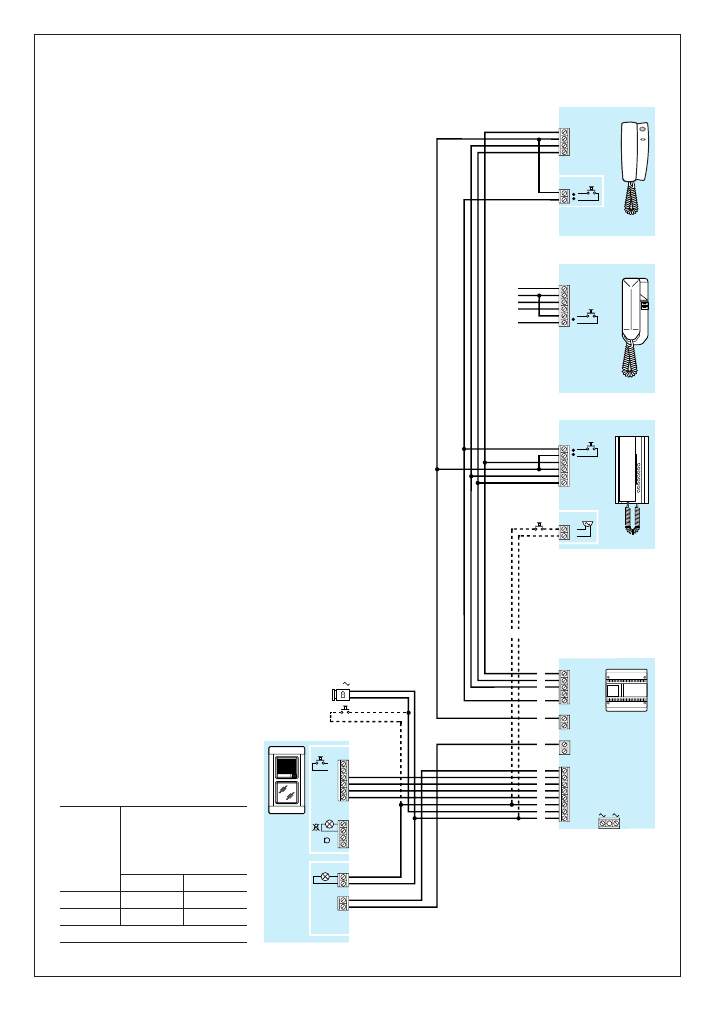
6
MCA/300
3
4
5
6
8
7
C
1
C
B
MC/1
TTS/2+
TMP/2+
MCA/300+
MC/1
AE
12V
-
+
B
B
B
B
B
B
A
A
A
A
B
D
E
C
E/310
4
5
6
7
8
9
10
11
1
2
1
2
1
2
3
5
6
CP
C
XC/200
1
5
7
8
9
ER/12
1
2
5
7
8
9
C
C/200
2
5
7
8
9
C
YP1
YC/200+YP1
2
B B
B
B
B
B
B
SE 9031.
1TM
IMPIANTO COSTITUITO DA 2 DERI-
VANTI INTERNI INTERCOMUNICAN-
TI CON CHIAMATA IN COMUNE DAL
POSTO ESTERNO TM
INSTALLATION USING 2 INTERCOM
HANDSETS ACTIVATED BY THE
SAME CALL BUTTON ON TM ENTRY
PANEL
INSTALLATION MIT 2 INTERCOM-
HÖRER AKTIVIERT DURCH EINEN
GEMEINSAMEN ANRUF ÜBER DIE
AUSSENSTATION TM
INSTALLATION A 2 POSTES A IN-
TERCOMMUNICATION SUR APPEL
UNIQUE DEPUIS LE POSTE EXTE-
RIEUR TM
CP:
Pulsante di chiamata dal pianerottolo.
Personal door-bell button.
Taste zum Anrufen von der Etage.
Bouton d’appel porte-palière.
AE:
Pulsante ausiliario apriporta.
Auxiliary door-lock release button.
Türöffnertaste (Auxiliary/Service).
Bouton gâche intérieur.
Distanza
Distance
Entfernung
Distance
(m)
(1) Ø 0,6 mm
200
100
Sezione dei conduttori
Cross section of cables
Aderenquerschnitte
Section des conducteurs
(mm
2
)
1
1,5
A
B
0,28(1)
0,50
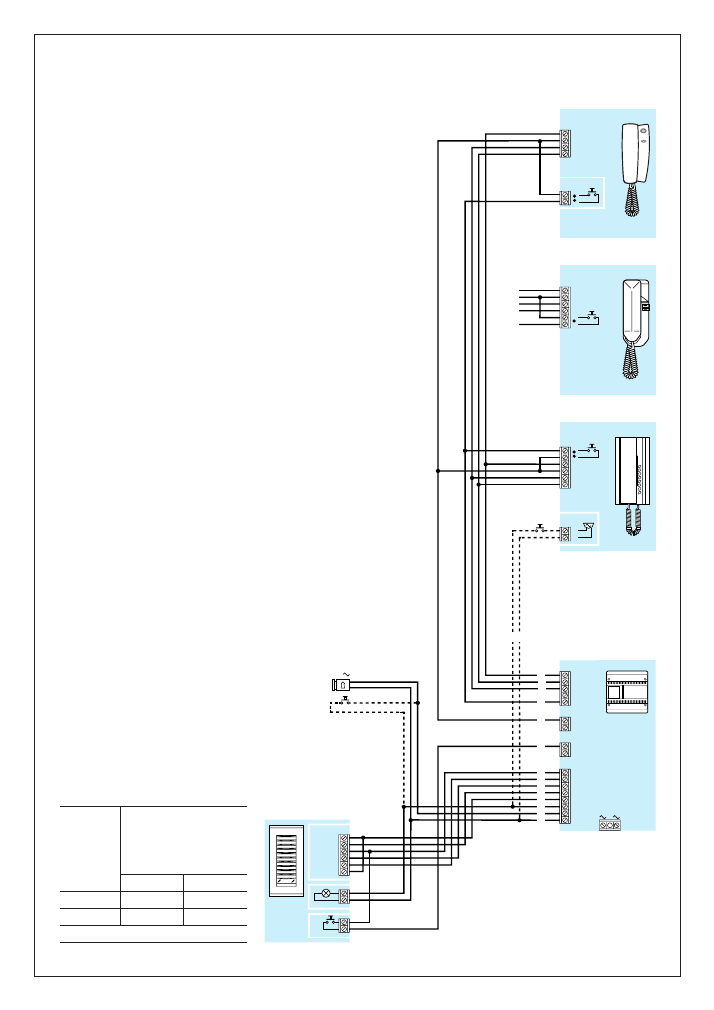
7
CP
C
XC/200
1
5
7
8
9
ER/12
1
2
A
B
D
E
C
E/310
1
2
1
2
1
2
3
5
6
AE
12V
HA/200
5
21
8
11
12
14
HPC/1+
HA/200+
HTS
B
4
5
6
7
8
9
10
11
B
B
B
B
B
A
A
A
B
B
B
B
B
B
B
5
7
8
9
C
C/200
2
5
7
8
9
C
YP1
YC/200+YP1
2
SE 9031.
1
IMPIANTO COSTITUITO DA 2 DERI-
VANTI INTERNI INTERCOMUNICAN-
TI CON CHIAMATA IN COMUNE DAL
POSTO ESTERNO TARGHA
INSTALLATION USING 2 INTERCOM
HANDSETS ACTIVATED BY THE
SAME CALL BUTTON ON TARGHA
ENTRY PANEL
INSTALLATION MIT 2 INTERCOM-
HÖRER AKTIVIERT DURCH EINEN
GEMEINSAMEN ANRUF ÜBER DIE
AUSSENSTATION TARGHA
INSTALLATION A 2 POSTES A IN-
TERCOMMUNICATION SUR APPEL
UNIQUE DEPUIS LE POSTE EXTE-
RIEUR TARGHA
CP:
Pulsante di chiamata dal pianerottolo.
Personal door-bell button.
Taste zum Anrufen von der Etage.
Bouton d’appel porte-palière.
AE:
Pulsante ausiliario apriporta.
Auxiliary door-lock release button.
Türöffnertaste (Auxiliary/Service).
Bouton gâche intérieur.
Distanza
Distance
Entfernung
Distance
(m)
(1) Ø 0,6 mm
200
100
Sezione dei conduttori
Cross section of cables
Aderenquerschnitte
Section des conducteurs
(mm
2
)
1
1,5
A
B
0,28(1)
0,50
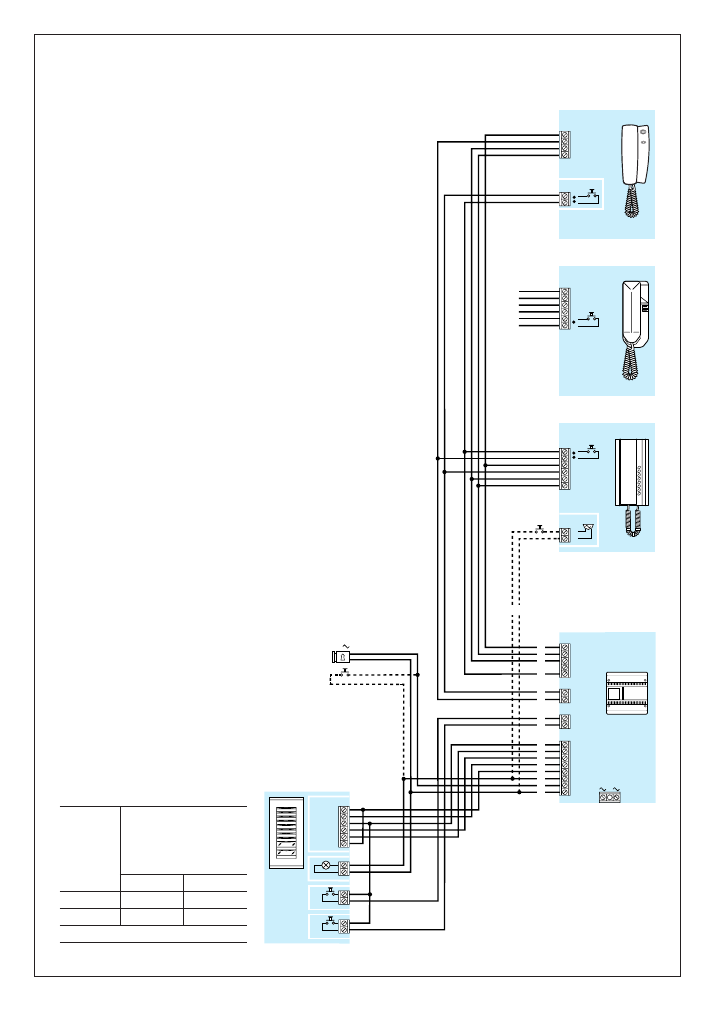
8
A
B
D
E
C
E/310
1
2
1
2
1
2
3
5
6
AE
12V
B
4
5
6
7
8
9
10
11
B
B
B
B
A
A
A
B
HA/200
5
1
2
21
8
11
12
14
HPC/1+
HA/200+
KHPS+
HTS
B
CP
C
XC/200
1
5
7
8
9
ER/12
1
2
B B
5
7
8
9
C
C/200
2
5
7
8
9
C
YP1
YC/200+YP1
2
B
B
B
B
B
B
SE 9032.
1
IMPIANTO COSTITUITO DA 2 DERI-
VANTI INTERNI INTERCOMUNICAN-
TI CON CHIAMATA INDIVIDUALE DAL
POSTO ESTERNO TARGHA
INSTALLATION USING 2 INTERCOM
HANDSETS HAVING INDIVIDUALLY
DEDICATED CALL BUTTON TARGHA
ON ENTRY PANEL
INSTALLATION MIT 2 INTERCOM-
HÖRER MIT INDIVIDUELLEM ANRUF
VON DER AUSSENSTATION TARGHA
INSTALLATION A 2 POSTES A
INTERCOMMUNICATION APPELES
INDIVIDUELLEMENT DEPUIS LE
POSTE EXTERIEUR TARGHA
CP:
Pulsante di chiamata dal pianerottolo.
Personal door-bell button.
Taste zum Anrufen von der Etage.
Bouton d’appel porte-palière.
AE:
Pulsante ausiliario apriporta.
Auxiliary door-lock release button.
Türöffnertaste (Auxiliary/Service).
Bouton gâche intérieur.
Distanza
Distance
Entfernung
Distance
(m)
(1) Ø 0,6 mm
200
100
Sezione dei conduttori
Cross section of cables
Aderenquerschnitte
Section des conducteurs
(mm
2
)
1
1,5
A
B
0,28(1)
0,50
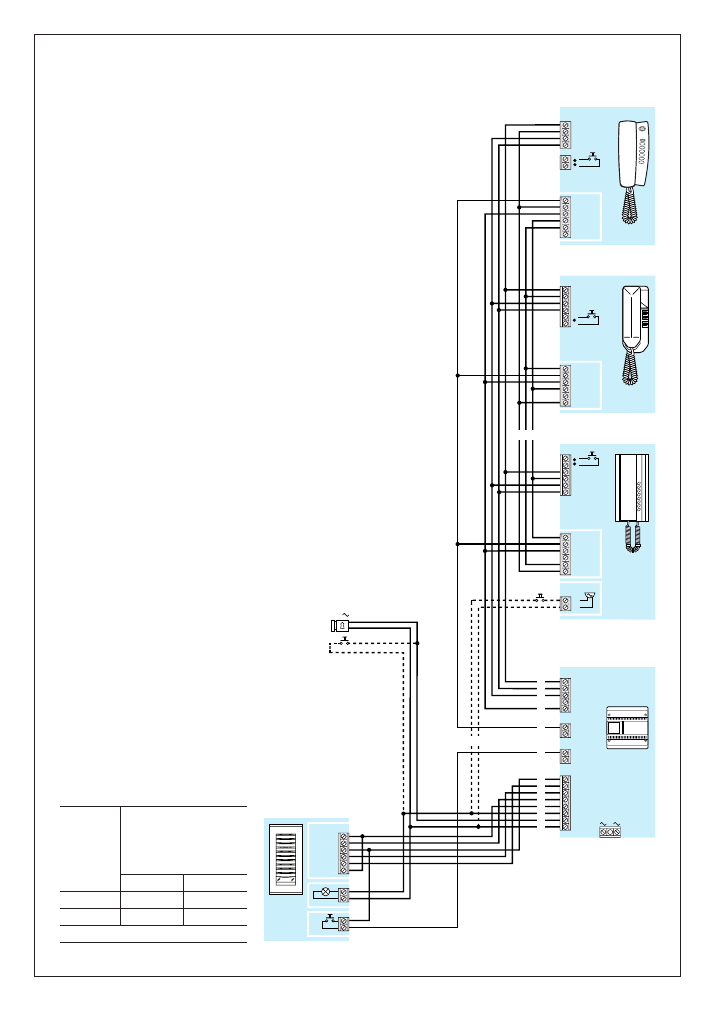
9
C/200+P3
2
3
C
5
7
8
9
P3
XC/200+XP3
1
C
XP3
5
7
8
9
A
B
D
E
C
E/310
1
2
1
2
1
2
3
5
6
AE
12V
B
CP
ER/12
1
2
4
5
6
7
8
9
10
11
12
7
13
14
15
16
B B
B
B
B
B
B
B
B
B
B
B
B
A
A
A
HA/200
5
21
8
11
12
14
HPC/1+
HA/200+
HTS
12
7
13
14
15
16
B
B
YC/200A+YP3
C
5
7
8
9
7
12
13
14
15
16
YP3
Distanza
Distance
Entfernung
Distance
(m)
SE 9033.
1
IMPIANTO COSTITUITO DA 3 DERI-
VANTI INTERNI INTERCOMUNICAN-
TI CON CHIAMATA IN COMUNE DAL
POSTO ESTERNO TARGHA
INSTALLATION USING 3 INTERCOM
HANDSETS ACTIVATED BY THE
SAME CALL BUTTON ON TARGHA
ENTRY PANEL
INSTALLATION MIT 3 INTERCOM-
HÖRER AKTIVIERT DURCH EINEN
GEMEINSAMEN ANRUF ÜBER DIE
AUSSENSTATION TARGHA
INSTALLATION A 3 POSTES A IN-
TERCOMMUNICATION SUR APPEL
UNIQUE DEPUIS LE POSTE EXTE-
RIEUR TARGHA
CP:
Pulsante di chiamata dal pianerottolo.
Personal door-bell button.
Taste zum Anrufen von der Etage.
Bouton d’appel porte-palière.
AE:
Pulsante ausiliario apriporta.
Auxiliary door-lock release button.
Türöffnertaste (Auxiliary/Service).
Bouton gâche intérieur.
(1) Ø 0,6 mm
200
100
Sezione dei conduttori
Cross section of cables
Aderenquerschnitte
Section des conducteurs
(mm
2
)
1
1,5
A
B
0,28(1)
0,50
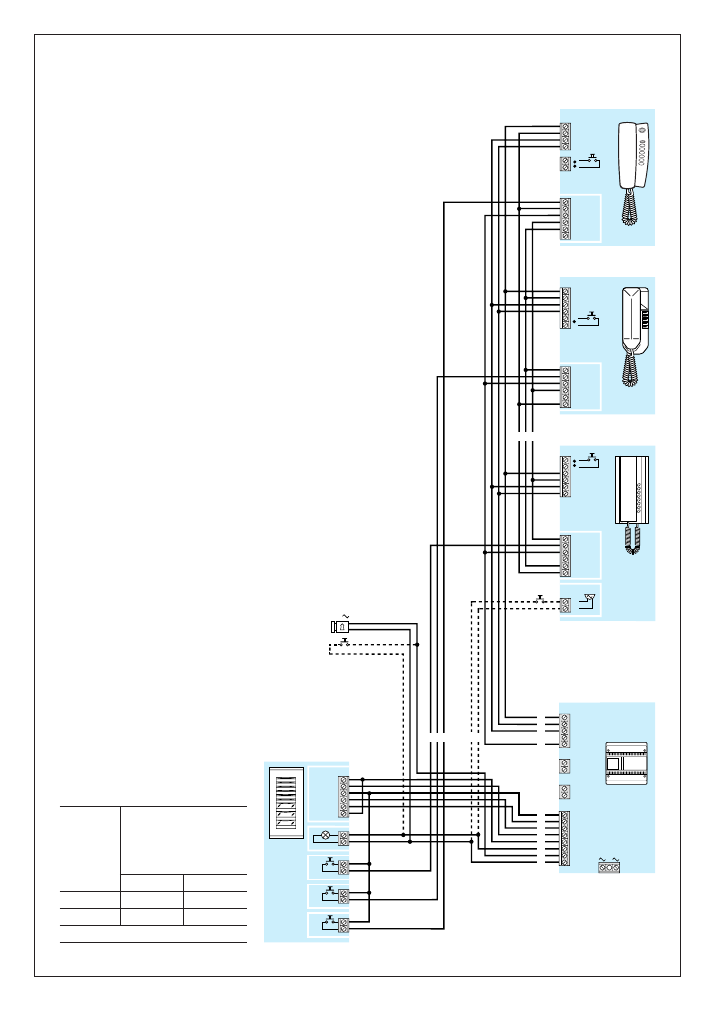
10
HA/200
5
21
8
11
12
14
HPC/1+
HA/200+
2 KHPS+
HTS
1
2
3
A
B
D
E
C
E/310
1
2
1
2
1
2
3
5
6
AE
12V
4
5
6
7
8
9
10
11
B
B
B
B
B
A
A
A
B
B
B
C/200+P3
2
3
C
5
7
8
9
P3
XC/200+XP3
1
C
XP3
5
7
8
9
CP
ER/12
1
2
12
7
13
14
15
16
B
B
B
12
7
13
14
15
16
YC/200A+YP3
C
5
7
8
9
7
12
13
14
15
16
YP3
B B
B
B
B
B
Distanza
Distance
Entfernung
Distance
(m)
SE 9034.
1
IMPIANTO COSTITUITO DA 3 DERI-
VANTI INTERNI INTERCOMUNICAN-
TI CON CHIAMATA INDIVIDUALE DAL
POSTO ESTERNO TARGHA
INSTALLATION USING 3 INTERCOM
HANDSETS HAVING INDIVIDUALLY
DEDICATED CALL BUTTON ON TAR-
GHA ENTRY PANEL
INSTALLATION MIT 3 INTERCOM-
HÖRER MIT INDIVIDUELLEM ANRUF
VON DER AUSSENSTATION TARGHA
INSTALLATION A 3 POSTES A
INTERCOMMUNICATION APPELES
INDIVIDUELLEMENT DEPUIS LE
POSTE EXTERIEUR TARGHA
CP:
Pulsante di chiamata dal pianerottolo.
Personal door-bell button.
Taste zum Anrufen von der Etage.
Bouton d’appel porte-palière.
AE:
Pulsante ausiliario apriporta.
Auxiliary door-lock release button.
Türöffnertaste (Auxiliary/Service).
Bouton gâche intérieur.
(1) Ø 0,6 mm
200
100
Sezione dei conduttori
Cross section of cables
Aderenquerschnitte
Section des conducteurs
(mm
2
)
1
1,5
A
B
0,28(1)
0,50
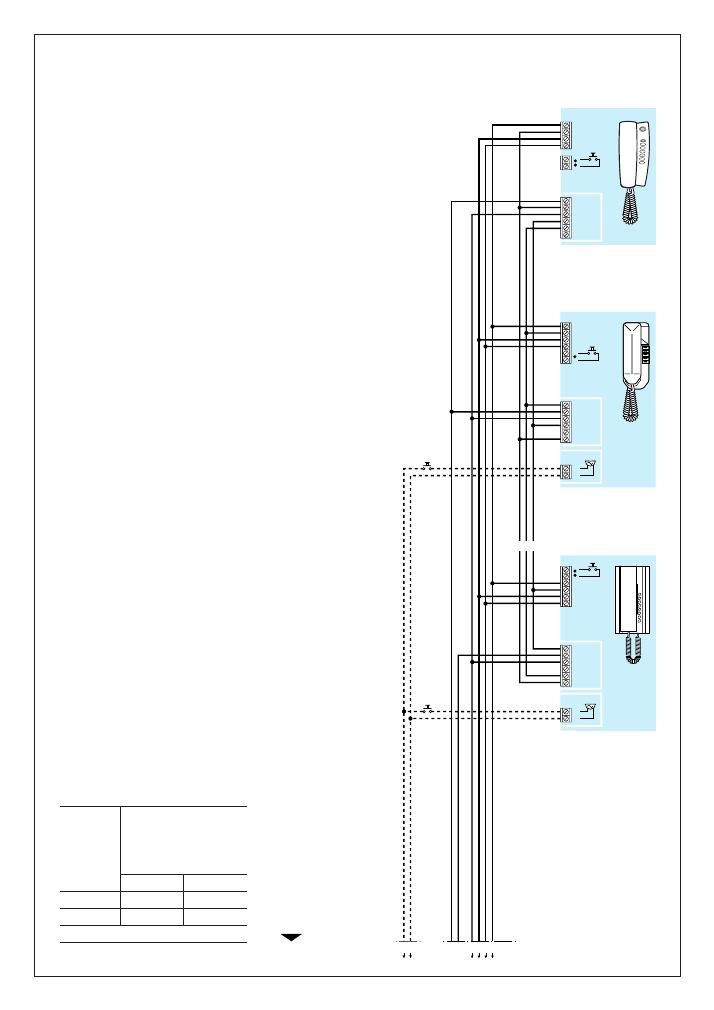
11
C/200+P3
2
C
5
7
8
9
P3
XC/200+XP3
1
C
XP3
5
7
8
9
CP
ER/12
1
2
12
7
13
14
15
16
B
B
B
1
2
1
2
3
6
5
9
8
13
ER/12
9
11
12
7
13
14
15
16
CP
ER/12
1
2
SE 9035.
1
-B
3
YC/200A+YP3
C
5
7
8
9
7
12
13
14
15
16
YP3
Distanza
Distance
Entfernung
Distance
(m)
SE 9035.
1
IMPIANTO COSTITUITO DA 3 DERI-
VATI INTERNI INTERCOMUNICANTI
C/200+P/3 E DOPPIO INGRESSO
(POSSIBILITA’ DI SEGNALAZIONE DI
INGRESSO OCCUPATO).
INSTALLATION USING 3 INTERCOM
HANDSETS C/200+P/3 AND 2
ENTRANCES.
OPTION: ENGAGED SIGNAL INDI-
CATOR.
INSTALLATION MIT 3 C/200+P/3
INTERCOM-HöRER UND MEHRE-
REN EINGÄNGEN.
OPTION: INDICATOR FÜR BESETZ-
TANZEIGE VLO/10.
INSTALLATION A 3 POSTES
C/200+P/3 A INTERCOMMUNICA-
TION. DOUBLE ENTREE ET POSSI-
BILITE DE SIGNALISATION OCCU-
PEE.
CP:
Pulsante di chiamata dal pianerottolo.
Personal door-bell button.
Taste zum Anrufen von der Etage.
Bouton d’appel porte-palière.
AE:
Pulsante ausiliario apriporta.
Auxiliary door-lock release button.
Türöffnertaste (Auxiliary/Service).
Bouton gâche intérieur.
(1) Ø 0,6 mm
200
100
Sezione dei conduttori
Cross section of cables
Aderenquerschnitte
Section des conducteurs
(mm
2
)
1
1,5
A
B
0,28(1)
0,50
SE 9035.
1
-A
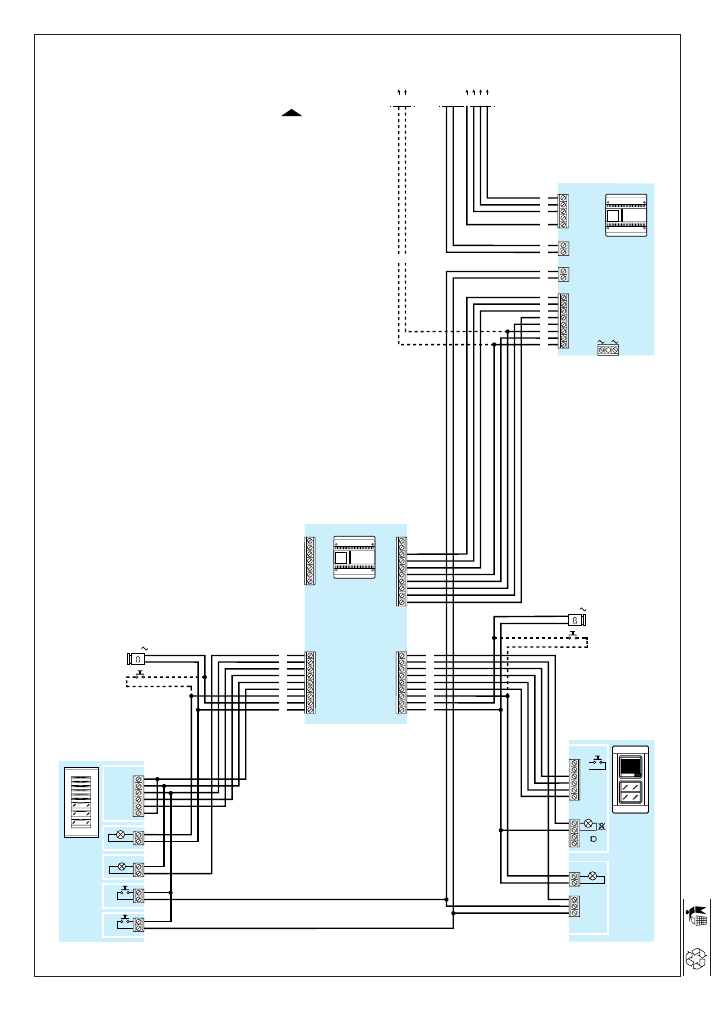
12
C
E/400
D
B
E
19
18
17
16
15
14
13
12
11
10
1
2
3
4
5
6
7
B
B
B
B
B
B
B
B
A
A
A
B
B
B
A
B
D
E
C
E/310
4
5
6
7
8
9
10
11
1
2
1
2
1
2
3
5
6
AE
12V
A
1
HA/200
5
21
8
11
12
14
HPC/1+
HA/200+
KHPS+
HTS+
KHSO
1
KHSO
28
27
26
25
24
23
22
21
20
A
A
B
B
B
B
B
B
2-3
B
B
1
2
SE 9035.
1
-A
1
2
3
6
5
9
8
13
ER/12
9
11
B B
MCA/300
3
4
5
6
8
7
C
1
2-3
C
B
MC/2
TTS/2+
TMP/2+
MCA/300+
MC/2
AE
12V
-
+
2
1
2
3
4
5
6
7
8
9
A
A
A
B
B
B
B
B
B
SE 9035.
1
-B